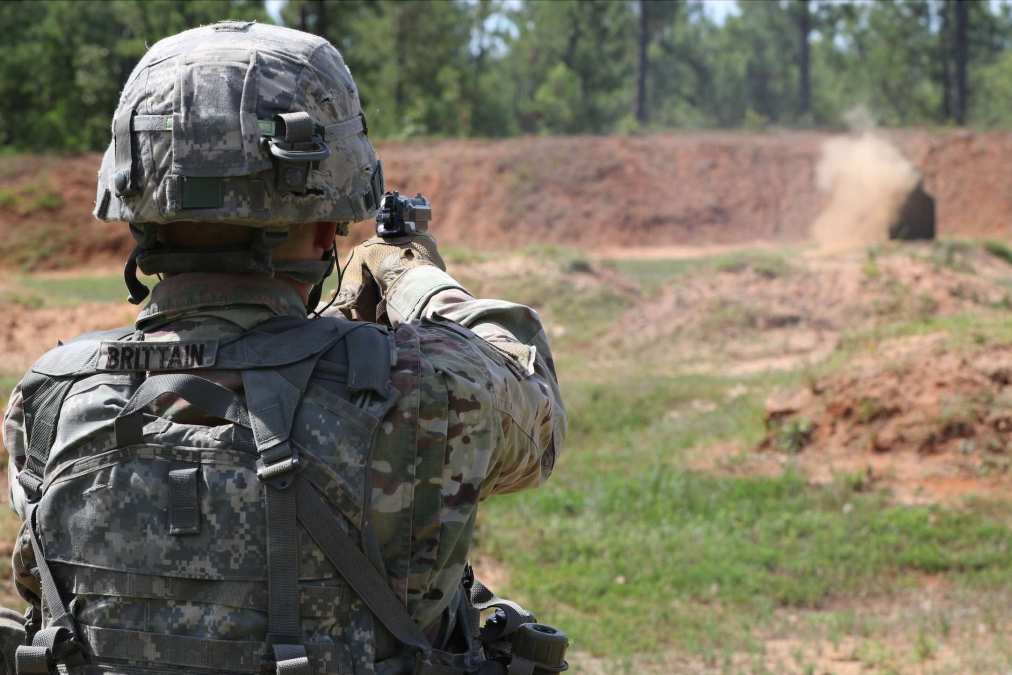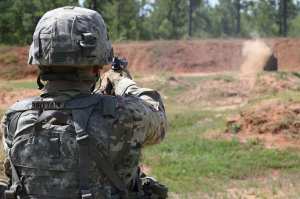How one corps is trying to modernize the Army

Last summer, the Army’s highest-ranking general had a meeting with the three-star commander in charge of some of the service’s most elite forces. The purpose of this encounter was not a briefing on readiness or a new war game, but a chance for Chief of Staff Gen. James McConville to deliver a challenge to his subordinate at the 18th Airborne Corps: Build the corps of the future.
McConville’s meeting with Commander Lt. Gen. Erik Kurilla sparked the creation of a new program at the corps’ home in Fort Bragg, N.C., dubbed Project Ridgway after Gen. Matthew Ridgway, the corps’ first commander. Unlike the Army’s plethora of existing programs dedicated to developing new technologies, Project Ridgway is an experiment to not only field those new technologies but also develop cultures that support them, senior project leaders say.
“We have to create a culture in the corps where soldiers know they have the ability to see a problem…and actually be a part of a solution,” Col. Jeff Worthington, deputy director and senior technical adviser to Project Ridgway, told FedScoop in an exclusive interview.
Policy leaders have for many years advocated for faster technological development to ensure the U.S. military is equipped to face future threats. That military-wide transformation can’t happen without its largest component, the Army, changing — nor can the Army change without its corps changing, and so down the list of units that leaders say need to be reformed.
“We cannot be an Industrial Age army in the Information Age,” Gen. McConville wrote in 2019 in his initial message to the Army when he took over as top officer. “We must transform all linear industrial age processes to be more effective, protect our resources, and make better decisions. We must be the Army of tomorrow, today.”
The 18th Airborne Corps — often called the nation’s “contingency force,” as it must be ready to fight anywhere in the world with “18 hours’ notice” — saw itself as a ripe candidate to lead that change from a unit level.
Small steps
Project Ridgway is built around four lines of effort: culture change, upskilling data and tech literacy, using data as an asset, and building an artificial intelligence-enabled infrastructure.
“[We] needed to make the first AI-ready corps; we could never be AI-ready if we were not data ready first,” Worthington said.
Ridgway shares a similar mission with many other bodies in the Army, like Army Futures Command, cross-functional teams and task forces focused on modernization. But what’s unique, its leaders say, is its drive to operationalize at the lowest level possible the use of the tech, not just its development.
Despite big ambitions, so far the corps has taken small steps, posting an open job position for a chief data officer and holding several rounds of its “Shark Tank”-style pitch event called the “Dragon’s Lair.” A dozen or so soldiers from the corps in February participating in data boot camps, with more expected to take internships at U.S. Special Operations Command — the unified combatant command that has taken the lead on many of the military’s data and AI-initiatives.
Additionally, the team is the first to develop an application entirely in the cARMY cloud environment and has adopted parts of the Department of Defense Joint AI Center’s “data fabric,” its cleaned-up data architecture available for use.
“We are moving out and I think we are breaking down some of the bureaucracy,” said Col. Dan Kearney, the project’s director.
A soldier-developed app for range finding
To showcase the type of work Project Ridgway hopes to foster, its leaders walked FedScoop through a project meant to be like an Airbnb for shooting ranges — small in scope, but representative of the type of culture the team wants to create.
Maj. Evan Adams, an operations planner in the 101st Airborne Division within the corps, came up with the idea to replace the current process, more akin to signing into a motel on carbon copy papers, with a smartphone app — an idea that he pitched to leadership and earned him resources to continue it development.
“It is an enduring issue in the military…we are pretty much stuck to our desks doing admin work,” Adams said. “We can do this stuff on our phone.”
The application itself will allow soldiers to schedule a spot at a range for shooting practice. It’s a mundane problem unique to soldiers who need to keep their shooting skills sharp and range managers who are burdened by paperwork and maintenance requirements.
That mismatch of time, effort and means to schedule time on the range is one part of what the “Range Finder” app is targeting. But it’s also a small use case for a larger ambition. Adams said the app will also collect data on range usage, feed predictive maintenance efforts and provide a starting example for what soldiers can accomplish when supported to provide their own solutions to challenges.
Ridgway leaders point to the Range Finder app as the first of many soldier-led tools they want to implement.
“Bottom line, we typically have to carry a bunch of books…It is 2021 — the book should fit in our pocket,” Adams said.
Formalizing innovation
The cadre of innovators across the Army remains an informal one, strung together in a shadow network of LinkedIn and Microsoft Teams connections. Adams said formalizing that network and putting time and resources behind soldiers’ ideas is what is needed to advance from one-off apps to the type of technology ecosystem the Army wants.
“We like to stay in the shadows,” Adams said. “We don’t know what we are doing; we just figure it out as we go.”
Other lines of effort in the project, like the data and tech upskilling, are more institutionalized means of attaining the goals of modernization. The internship and data boot camps are supported by Galvanize, a data and tech boot camp company. But it remains a small effort with only a handful of soldiers sent through the program on temporary assignments out of the tens of thousands in the corps.
The challenge on both ends becomes formalizing change without that processes overshadowing its initial goals. In Adams’ mind, that means burning everything the Army does down to the ground.
“If we want to apply this model and this thinking and saying this is a success, we are going to essentially have to burn what we thought was the right way of doing things and build anew,” he said.
Ultimately, Kearney, Adams and others take a long view of the approach they have started. The colonel said his unit of time is set to years, not months or weeks, to measure change. Adams too acknowledged that his app for finding ranges was a small start to a big problem.
“I don’t think these are short-term wins,” Kearney said.






